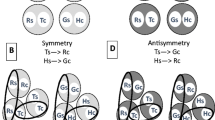Abstract
Background
The current study sought to extend the work of Stewart et al. (The Psychological Record, 52, 77–88, 2002) by investigating the effects of differing histories with regard to color on participant’s equivalence test performances.
Method
Thirty-two university students were divided into four groups exposed to different training procedures, but all were subsequently exposed to an identical equivalence test using colored stimuli (either red or green). Initially, participants were divided into two groups, one receiving training with stimuli colored either red or green (the All Color group), while the other received training with stimuli colored only black (Color Test group). In addition, half of the participants in both groups were exposed to exemplar training procedures (Exemplar Training groups), with the remaining participants simply receiving repeated test exposures (Repeat Groups).
Results
Results showed that participants in the All Color groups produced higher equivalence responding relative to participants in Color Test groups.
Conclusion
Exemplar training was shown to be effective in promoting equivalence responding only for participants in the All Color groups.




Similar content being viewed by others
References
Adams, B. J., Fields, L., & Verhave, T. (1993). Effects of test order on intersubject variability during equivalence class formation. The Psychological Record, 43, 133–152.
Barnes, D., Lawlor, H., Smeets, P. M., & Roche, B. (1995). Stimulus equivalence and academic self-concept among mildly mentally handicapped and non-handicapped children. The Psychological Record, 46, 87–107.
Barnes-Holmes, Y., Barnes-Holmes, D., Roche, B., & Smeets, P. M. (2001). Exemplar training and a derived transformation of functions in accordance with symmetry. The Psychological Record, 51, 287–308. Retrieved from http://opensiuc.lib.siu.edu/cgi/viewcontent.cgi?article=1311&context=tpr.
Barnes-Holmes, Y., Barnes-Holmes, D., Smeets, P. M., Strand, P., & Friman, P. (2004). Establishing relational responding in accordance with more-than and less-than as generalized operant behavior in young children. International Journal of Psychology and Psychological Therapy, 4, 531–558. Retrieved from http://eprints.nuim.ie/403/1/Psyc22.pdf.
Fields, L., Adams, B. J., Verhave, T., & Newman, S. (1990). The effects of nodality on the formation of equivalence classes. Journal of the Experimental Analysis of Behavior, 53, 345–358.
Hayes, S. C., Gifford, E., & Ruckstuhl, L. E. (1996). Relational frame theory and a behavioural approach to executive function. In R. Lyon (Ed.), Attention, memory, and executive function. Baltimore: Brookes.
Murphy, C., Barnes-Holmes, D., & Barnes-Holmes, Y. (2005). Derived manding in children with autism: synthesizing Skinner’s verbal behavior with relational frame theory. Journal of Applied Behavior Analysis, 38, 445–462. doi:10.1901/jaba.2005.97-04.
Reese, H. W. (1968). The perception of stimulus relations: Discrimination learning and transposition. New York: Academic.
Roche, B., Barnes, D., & Smeets, P. M. (1997). Incongruous stimulus pairing contingencies and conditional discrimination training: effects on relational responding. Journal of the Experimental Analysis of Behavior, 68, 143–160.
Sidman, M. (1971). Reading and auditory visual equivalences. Journal of Speech and Hearing Research, 14, 5–13.
Sidman, M. (1994). Equivalence relations and behaviour: A research story. Boston: Authors Cooperative.
Stewart, I., Barnes-Holmes, D., Roche, B., & Smeets, P. M. (2002). Stimulus equivalence and non-arbitrary relations. The Psychological Record, 52, 77–88. Retrieved from http://opensiuc.lib.siu.edu/cgi/viewcontent.cgi?article=1168&context=tpr.
Watt, A., Keenan, M., Barnes, D., & Cairns, E. (1991). Social categorization and stimulus equivalence. The Psychological Record, 41, 33–50.
Author information
Authors and Affiliations
Corresponding author
Rights and permissions
About this article
Cite this article
Kenny, N., Devlin, S., Barnes-Holmes, D. et al. Competing Arbitrary and Nonarbitrary Stimulus Relations: The Effect of Exemplar Training in Adult Participants. Psychol Rec 64, 53–61 (2014). https://doi.org/10.1007/s40732-014-0004-4
Published:
Issue Date:
DOI: https://doi.org/10.1007/s40732-014-0004-4




